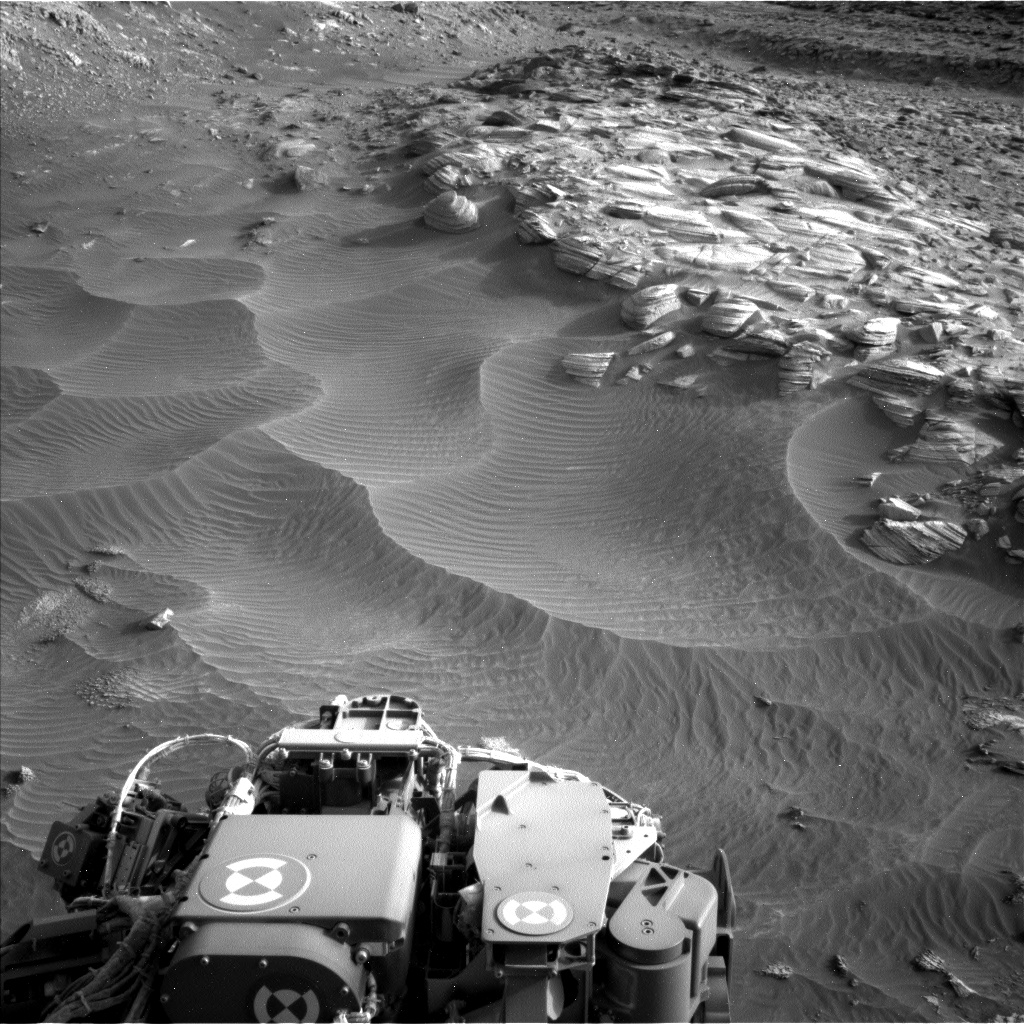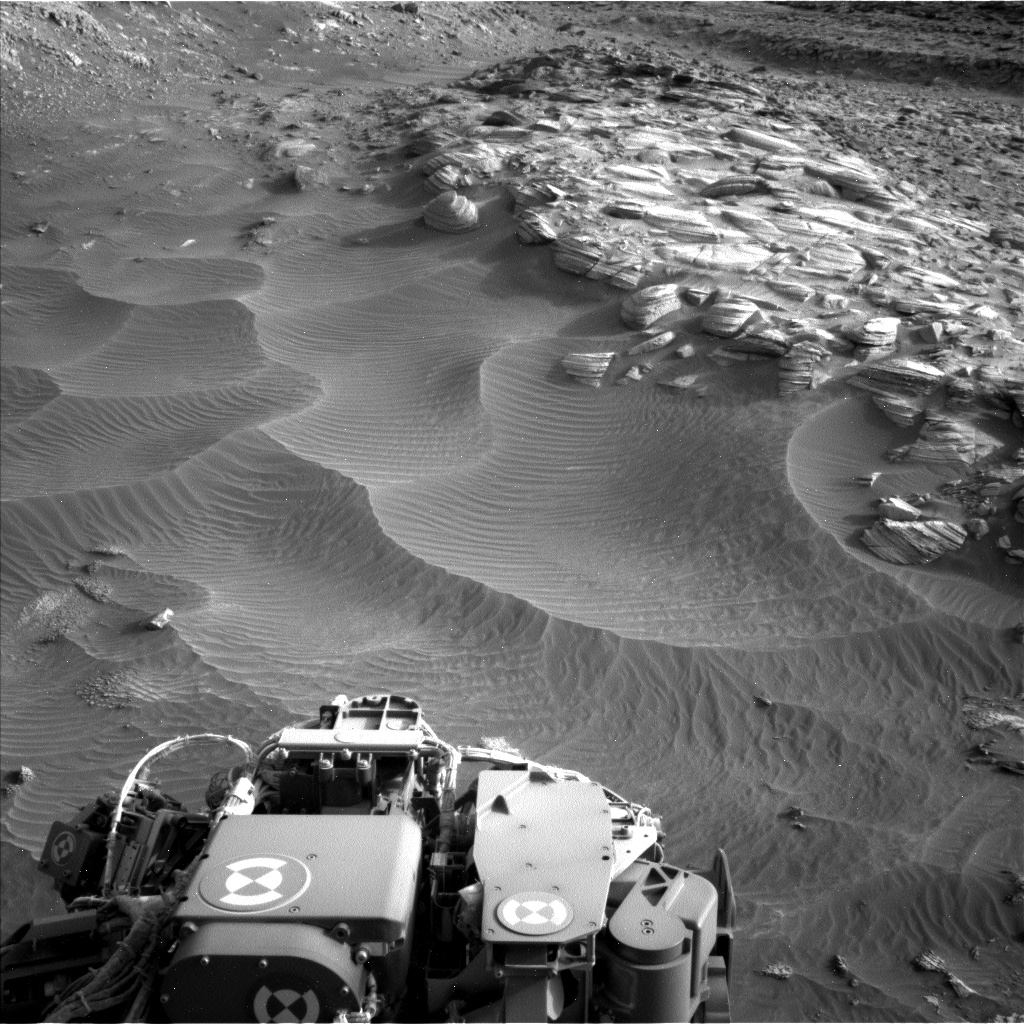Curiosity Navigation Curiosity Home Mission Overview Where is Curiosity? Mission Updates Science Overview Instruments Highlights Exploration Goals News and Features Multimedia Curiosity Raw Images Images Videos Audio More Resources Mars Missions Mars Sample Return Mars Perseverance Rover Mars Curiosity Rover MAVEN Mars Reconnaissance Orbiter Mars Odyssey More Mars Missions The Solar System The Sun Mercury Venus Earth The Moon Mars Jupiter Saturn Uranus Neptune Pluto & Dwarf Planets Asteroids, Comets & Meteors The Kuiper Belt The Oort Cloud 2 min read
Sols 4323-4324: Surfin’ Our Way out of the Channel  An image from NASA’s Mars rover Curiosity, looking back at the western edge of the Gediz Vallis deposit (top left) and the channel wall in the sulfate unit with unconsolidated sand/soil deposits in the foreground. This image was taken by Curiosity’s Left Navigation Camera on Sol 4321 — Martian day 4,321 of the Mars Science Laboratory mission — on Oct. 2, 2024, at 02:13:27 UTC. NASA/JPL-Caltech Earth planning date: Wednesday, Oct. 2, 2024
An image from NASA’s Mars rover Curiosity, looking back at the western edge of the Gediz Vallis deposit (top left) and the channel wall in the sulfate unit with unconsolidated sand/soil deposits in the foreground. This image was taken by Curiosity’s Left Navigation Camera on Sol 4321 — Martian day 4,321 of the Mars Science Laboratory mission — on Oct. 2, 2024, at 02:13:27 UTC. NASA/JPL-Caltech Earth planning date: Wednesday, Oct. 2, 2024
As a member of the group tasked with organizing our campaign to investigate the Gediz Vallis channel and deposit (informally known as the Channel Surfers), I was a little sad this morning to see that our drive had successfully taken us out of the channel, back onto the magnesium sulfate-bearing unit, into which the channel is incised. Our long-anticipated investigation of the channel has proven fruitful: Curiosity made the first definitive detection of elemental sulfur on Mars, and we have examined a variety of intriguing lithologies and relationships within the deposit over the last 4.5 months. It has been an exciting time, and I have particularly enjoyed riding this wave with my fellow Channel Surfers — a great team! Now to make sense of all the fantastic data we have collected.
We are not completely done looking at the channel and deposits though. We will be driving parallel to the western margin for a while to facilitate comparisons with what we observed from the east. Tosol we will image two areas of interest within the Gediz Vallis channel from our current vantage point with Mastcam and ChemCam long-distance RMI. But back to the sulfate unit — the team planned a number of activities to document the return to the sulfate unit. These include APXS and MAHLI of the nodular bedrock immediately in front of the rover (“Sub Dome”), ChemCam LIBS and Mastcam of another bedrock block (“Vert Lost Grove”), and Mastcam of the resistant bedrock ridge immediately adjacent to the Gediz Vallis channel (“Muah Mountain”).
Once the drive of about 25 meters (about 82 feet) hopefully executes successfully, Curiosity will look down and image the terrain between her front wheels with MARDI, acquire ChemCam LIBS on an autonomously selected target in the workspace, and then perform a series of atmospheric and environmental observations. These include a Mastcam tau to measure dust in the atmosphere, Navcam dust devil and suprahorizon movies, and a Navcam line-of-sight observation. The plan is rounded out with DAN, RAD, and REMS activities.
Written by Lucy Thompson, Planetary Geologist at University of New Brunswick
Details Last Updated Oct 03, 2024 Related Terms Blogs
Keep Exploring Discover More Topics From NASA Mars
Mars is the fourth planet from the Sun, and the seventh largest. It’s the only planet we know of inhabited…

Explore this collection of Mars images, videos, resources, PDFs, and toolkits. Discover valuable content designed to inform, educate, and inspire,…

Each robotic explorer sent to the Red Planet has its own unique capabilities driven by science. Many attributes of a…

Mars Exploration: Science Goals
The key to understanding the past, present or future potential for life on Mars can be found in NASA’s four…



 2 min read Sols 4321-4322: Sailing Out of Gediz Vallis
2 min read Sols 4321-4322: Sailing Out of Gediz Vallis
 2 min read Sols 4318-4320: One Last Weekend in the Channel
2 min read Sols 4318-4320: One Last Weekend in the Channel
 4 min read Sols 4316-4317: Hunting for Sulfur
4 min read Sols 4316-4317: Hunting for Sulfur
